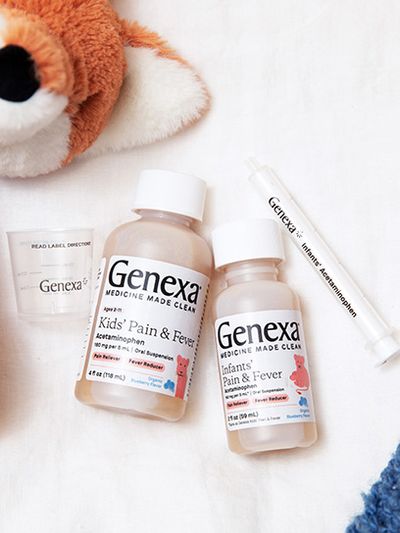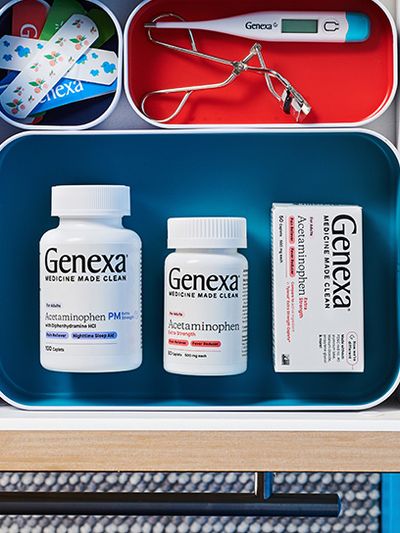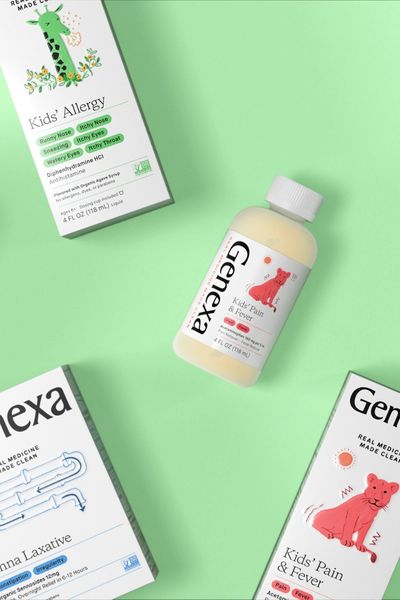Acetaminophen For Children: Understanding Proper Dosage
How Much Acetaminophen Should You Give Your Child?
Table of contents:
Children experience any number of aches, pains, illnesses, and fevers while growing up, and sometimes, a medication like acetaminophen may be needed to help relieve symptoms.
Acetaminophen is an over the counter pain medication and fever reducer that is commonly given to children and adults alike, but when giving the medication to kids, understanding the proper dosage of acetaminophen for children is critical.
What is acetaminophen?
Acetaminophen is an over-the-counter medication that is commonly used to reduce fever and pain in adults and children.
Acetaminophen is sold under many different brand names, the most common of which is Tylenol®, and is sold in some countries under the generic name paracetamol.
Acetaminophen is considered a safe medication when used as directed, but when given at too large a dose, acetaminophen can cause serious side effects and make your child very sick. Acetaminophen should never be given to a child under the age of 2 without a doctor’s approval.
What forms of acetaminophen are available?
While adults may commonly use acetaminophen in the form of an oral tablet, kids usually use the medication in a different form.
Children, who may have difficulty swallowing pills, are more likely to use the medication in the form of an oral suspension (liquid) or chewable tablets. In general, doctors recommend that children below the age of six use acetaminophen in the form of an oral suspension to avoid choking hazards that are associated with chewable tablets that are chewed incompletely.
Children ages six and older may use an oral suspension or chewable tablets. Children who struggle to take medication by mouth or who cannot keep medication down due to vomiting may benefit from using acetaminophen in the form of a rectal suppository.
What do parents need to know before giving a child acetaminophen?
When considering giving your child acetaminophen, there are several important steps that you need to take even before checking the label to find the correct dosage. Make sure you do each of the following first.
- Check the expiration date printed on the label. All medication comes with an expiration date, so the first step before preparing to give acetaminophen to your child is to check the expiration date. If the product is expired, throw the medication away and buy more. Make sure to dispose of the medication safely by removing it from its original container, mixing it with an undesirable substance that kids and pets won’t try to eat, and place it in a sealed bag in the trash can.
- Check the label of other medications that your child is taking to ensure that they do not contain acetaminophen. Many different types of cold, flu, cough, and pain medication contain acetaminophen, so it’s important to make sure that your child isn’t already consuming acetaminophen in another product, as this will influence the dosage of the medication that they can use safely. Taking too much acetaminophen can cause liver damage in children, so speak to your child’s doctor or pharmacist if your child is already taking a medication that contains this ingredient.
- Check the label for the concentration and dosage.Depending on the manufacturer, acetaminophen may be available in a number of different concentrations, affecting the dosage of the medication. Most children’s medications come with a cup, dropper, or syringe to help you measure out the right dose of the medication; make sure you use the dosing device that came with the medication.
- Check your child’s temperature if giving the medication for fever.Depending on the child’s age and temperature, they may require medical attention instead of acetaminophen. Infants ages three months and younger with a rectal temperature of 100.4°F (38°C) or higher should receive immediate medical attention. Children between the ages of three months and three years of age with a fever of 102.2°F (39°C) or higher may need medical attention, so call your doctor right away if this occurs.
- Sensitivity to dyes: Some brands of acetaminophen contain certain artificial dyes or colors. For children sensitive to dyes, look for an acetaminophen product that does not contain any of these artificial fillers.
What is the correct dose of acetaminophen for kids?
Because it’s so important to give your child the correct dose of acetaminophen in order to prevent liver damage, you should follow dosing instructions that provide recommended dosages by weight rather than by age. Therefore, weigh your child before providing them with acetaminophen if they have not been weighed recently.
It’s important to know which concentration of acetaminophen your product contains so that you do not give too much of the medication. Make sure to contact your child’s doctor if you’re unsure about the right amount of acetaminophen to give your child.
The information below is intended to serve as a guide only and should not replace the advice of a doctor. Make sure to check with your doctor before giving acetaminophen to a child under the age of two.
Dosage for Liquids or Tablets
Check the label of the product to determine how much acetaminophen is in one tablet, teaspoon (tsp) or five milliliters (mL). Tablets typically give the dose of the medication in milligrams (mg) per tablet, while liquids typically provide the dose in mg per tsp or five mL. Always use the dosing device (spoon, syrup, or syringe) that comes with your medication and do not substitute a dosing device from home or another medication.
For children that weigh between 24 to 35 lbs (10.9 to 15.9 kilograms):
- For oral suspension that says 160 mg/5 mL on the label, give one dose of 5 mL
- For oral suspension that says 160 mg/1 tsp on the label, give a dose of 1 tsp
- For chewable tablets that say 80 mg on the label, give a dose of 2 chewable tablets
For children that weigh between 36 to 47 lbs (16 to 21 kilograms):
- For oral suspension that says 160 mg/5 mL on the label, give one dose of 7.5 mL
- For oral suspension that says 160 mg/1 tsp on the label, give one dose of 1 ½ tsp
- For chewable tablets that say 80 mg on the label, given one dose of 3 tablets
For children that weigh between 48 to 59 lbs (21.5 to 26.5 kilograms):
- For oral suspension that says 160 mg/5 mL on the label, give one dose of 10 mL
- For oral suspension that says 160 mg/1 tsp on the label, give one dose of 2 tsp
- For chewable tablets that say 80 mg on the label, give one dose of 4 tablets
For children that weigh between 60 to 71 lbs (27 to 32 kilograms):
- For oral suspension that says 160 mg/5 mL on the label, give one dose of 12.5 mL
- For oral suspension that says 160 mg/1 tsp on the label, give one dose of 2 ½ tsp
- For chewable tablets that say 80 mg on the label, give one dose of 5 tablets
- For chewable tablets that say 160 mg on the label, give one dose of 2 ½ tablets
For children that weigh between 72 to 95 lbs (32.6 to 43 kilograms):
- For oral suspension that says 160 mg/5 mL on the label, give one dose of 15 mL
- For oral suspension that says 160 mg/1 tsp on the label, give one dose of 3 tsp
- For chewable tablets that say 80 mg on the label, give one dose of 6 tablets
- For chewable tablets that say 160 mg on the label, give one dose of 3 tablets
For children that weigh between 96 lbs (43.5 kilograms) or more:
- For oral suspension that says 160 mg/5 mL on the label, give one dose of 20 mL
- For oral suspension that says 160 mg/1 tsp on the label, give one dose of 4 tsp
- For chewable tablets that say 80 mg on the label, give one dose of 8 tablets
- For chewable tablets that say 160 mg on the label, give one dose of 4 tablets
You may give your child another dose of acetaminophen every four to six hours; however, children should not receive more than five doses in a 24-hour period.
Dosage for Suppositories
Children who are over the age of six months and not able to take medication by mouth or who are vomiting can use acetaminophen suppositories, which are inserted rectally. The dosing for rectal suppositories is typically based on age.
For children between the ages of 6 to 11 months:
- For infant suppositories that read 80 milligrams (mg) on the label, give a dose of one suppository every six hours and no more than four doses in 24 hours.
For children between the ages of 12 to 36 months:
- For infant suppositories that read 80 milligrams (mg) on the label, give a dose of one suppository every four to six hours and no more than five doses in 24 hours.
For children between the ages of 3 to 6 years:
- For children's suppositories that read 120 mg on the label, give a dose of one suppository every 4 to 6 hours and no more than 5 doses in 24 hours
For children between the ages of 6 to 12 years:
- For junior-strength suppositories that read 325 mg on the label, give a dose of one suppository every 4 to 6 hours and no more than 5 doses in 24 hours
For children between the ages of 12 years and over:
- For junior-strength suppositories that read 325 mg on the label, give a dose of two suppositories every 4 to 6 hours and no more than 6 doses every 24 hours
Summary
When giving your child acetaminophen, make sure that you know their weight, as most dosing instructions are provided based on weight. When in doubt, you may look back at your child's last well-check up paperwork for this information.
Acetaminophen is generally considered a safe medication when given at the proper dosage, and there are few, if any, side effects associated with the medication.
Talk to your child’s doctor or pharmacist if you have any questions about how much acetaminophen to give your child.






